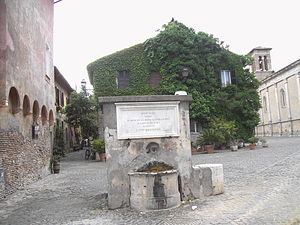- Ostia Antica (district)
-
For other places with the same name, see Ostia (disambiguation).
Ostia Antica is a district in the commune of Rome, Italy, five kilometers away from the coast. It is distinct from Ostia.
History
For ancient history of the site, see Ostia Antica.Under the Romans, Ostia Antica reached a peak of some 75,000 inhabitants in the 2nd and 3rd century AD. A slow decline began with the time of Constantine I, and the decaying conditions of the city were mentioned by St. Augustine when he passed through in the late 4th century. His mother, St. Monica, died in an inn here. The poet Rutilius Namatianus also reported the lack of maintenance of the city in 414. Ostia became an episcopal see as early as the 3rd century AD, with the cathedral (titulus) of Santa Aurea erected over the tomb of St. Monica.
As the centuries passed, Ostia fell into ruin but remained an access from the sea for visitors to Rome. Saracen pirates were a frequent concern; the naval Battle of Ostia was fought off the coast in 849. Pope Gregory IV fortified the existing burgh and it was rechristened Gregoriopolis. By this time, the shifting course of the Tiber had landlocked the ancient port, and the town was mainly a shelter for the workers of the nearby salt mills.
In the late 15th century, the bishop Giuliano della Rovere (later Pope Julius II) commissioned the rebuilding of the main church and town walls under the direction of the architect Baccio Pontelli. The Castle of Julius II, also built at this time, remains the most striking feature of modern Ostia. The castle was abandoned after a flood in 1587 flooded its moat and turned the surrounding area into a marsh.
The castle and the town were restored again in the 20th century.
In popular culture
- Ostia was featured in the novels I, Claudius and Claudius the God, both written by British novelist Robert Graves. The novels include scenes set at Ostia spanning from the reign of Augustus to the reign of Claudius, including the departure of Agrippa to Syria and Claudius's reconstruction of the harbour. In the 1976 television series, Ostia was frequently mentioned but never actually seen.
- Ostia appears briefly towards the end of the Roman Empire section of the 1981 comedy film History of the World, Part I, where the main characters board a galleon (bearing the El Al logo) bound for Judaea. In the film, however, Ostia is only ever referred to as simply "the port".
Sources
- Lorenzatti Sandro, Ostia. Storia Ambiente Itinerari Roma 2007 (Rome:Genius Loci)
- Site of the Centro Studi Storici Ambientali Ostia and of Genius Loci Publisher (Italian)
Categories:- Districts of Rome
- Castles in Italy
Wikimedia Foundation. 2010.


